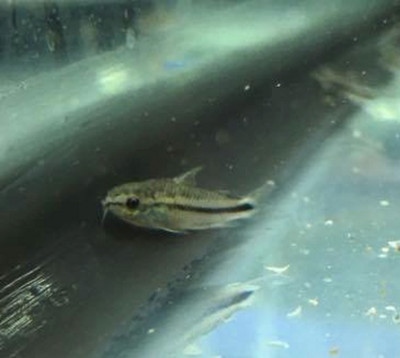Pygmy Corydoras
Posted by Max Gandara on on 28th May 2025
Pygmy Corydoras: The Tiny, Lively Bottom-Dweller Perfect for Community Tanks
If you’re looking for a small, peaceful, and active catfish to add charm and life to your aquarium’s bottom layer, the Pygmy Corydoras (Corydoras pygmaeus) are a fantastic choice. These miniature catfish pack a lot of personality into their tiny 1-inch bodies and make wonderful companions in planted community tanks.
Let’s explore what makes the Pygmy Corydoras such a beloved species and how to care for them.
What Are Pygmy Corydoras?
Pygmy Corydoras are among the smallest members of the Corydoras genus, growing to about 1 to 1.5 inches in length. They are native to slow-moving streams and floodplain lakes in South America and are known for their peaceful, schooling behavior and active foraging.
Their slender bodies have a distinctive horizontal black stripe running from their nose to the base of the tail, set against a silver or pale tan background, giving them a sleek and elegant appearance.
Why Choose Pygmy Corydoras?
-
Small Size: Perfect for smaller tanks (10 gallons or larger) and planted aquariums.
-
Peaceful and Social: Thrive in groups of 6 or more, displaying schooling behavior that is delightful to watch.
-
Bottom Cleaners: Actively forage for leftover food, helping keep the tank clean.
-
Active and Hardy: Adaptable to a range of water conditions and highly active throughout the day.
Tank Setup and Care
-
Tank Size: Minimum 10 gallons for a small group (6 or more). Larger tanks allow for more natural behavior.
-
Water Temperature: 72–79°F (22–26°C).
-
pH Range: 6.0–7.5.
-
Substrate: Fine sand or smooth gravel to protect their delicate barbels.
-
Decor: Plenty of plants, driftwood, and hiding spots to mimic their natural habitat.
-
Filtration: Gentle filtration to maintain clean, oxygenated water without strong currents.
Feeding Pygmy Corydoras
These catfish are omnivores and enjoy a varied diet:
-
High-quality sinking pellets or wafers designed for bottom feeders.
-
Live or frozen foods like bloodworms, daphnia, and brine shrimp.
-
Vegetable matter such as blanched zucchini or cucumber slices.
-
Feed small amounts 1–2 times daily, ensuring food reaches the bottom.
Behavior and Tankmates
-
Best kept in groups of at least 6 to exhibit natural schooling behavior.
-
Peaceful and compatible with most small, non-aggressive fish such as tetras, rasboras, and small barbs.
-
Avoid large or aggressive fish that may bully or eat them.
Breeding Pygmy Corydoras
Breeding these little catfish can be rewarding:
-
Provide soft, slightly acidic water with temperatures around 75–78°F.
-
Feed high-quality live and frozen foods to condition breeding pairs.
-
They scatter eggs on plants and tank surfaces; removing adults or providing breeding nets helps protect the fry.
-
Fry are tiny and require infusoria or specially prepared fry food initially.
Final Thoughts
The Pygmy Corydoras is a charming, active, and peaceful fish perfect for small to medium community tanks. Their tiny size, social nature, and constant bottom activity make them a joy to watch and care for. If you want a lively little catfish that adds both personality and practical cleanup to your aquarium, the Pygmy Corydoras is a top pick!
Thinking of adding Pygmy Corydoras to your aquarium? Make sure to keep them in groups and provide a peaceful, planted environment to see them thrive!

